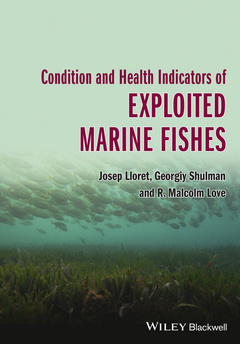Condition and Health Indicators of Exploited Marine Fishes
Auteurs : Lloret Josep, Shulman Georgiy, Love R. Malcolm

Condition and Health Indicators of Exploited Marine Fishes provides a comprehensive introduction to the study of fish condition that will assist advanced undergraduate and postgraduate students, researchers and professionals, working in marine ecology and biology, fisheries biology, environmental sciences and fish pathology. All universities and research establishments where biological and environmental sciences, fisheries and aquaculture are studied and taught should have copies of this book on their shelves.
Preface xi
Acknowledgments xiv
1 Description of condition indicators 1
1.1 Morphometric indicators 3
1.1.1 Fulton’s K condition factor 4
1.1.2 Le Cren’s relative condition factor (Kn) 5
1.1.3 Relative weight (Wr) 6
1.1.4 Other methods based on weights and lengths 6
1.1.5 Limits of use of morphometric condition indicators 7
1.2 Organosomatic (bioenergetic or morphophysiological) indicators 12
1.2.1 Hepatosomatic index (liver index or relative liver condition) 12
1.2.2 Mesenteric (adipose or perivisceral) fat index 15
1.2.3 Digestivosomatic index or digestive index 16
1.2.4 Limits of applicability of organosomatic indicators 16
2 Physiological and biochemical condition indicators: their relevance in fish metabolism 17
2.1 Basic concepts 19
2.1.1 Energy expenditures 19
2.1.2 Sub-organism metabolism 22
2.1.3 Blood: transport of energy 22
2.1.4 Alternative pathways of energy catabolism 23
2.1.5 Energy anabolism: accumulation of energy 23
2.2 Lipids 24
2.2.1 Lipids as energy substrates 24
2.2.2 Lipids as structural metabolic substrates 24
2.2.3 Fatty acids 26
2.2.4 Lipid analysis 27
2.2.5 Rapid methods for fat measurement in fish 32
2.3 Carbohydrates 37
2.4 Proteins and products of protein and nitrogenous metabolism 38
2.5 Nucleic acid-based indicators 39
2.6 Enzymes and some other indicators of intermediate metabolism 41
2.7 Hormones and other biologically active substances 41
3 Indicators of functional activity 42
3.1 Significance of condition indicators of functional activity in fish 42
3.2 Applied recommendations 51
4 Fish condition and life history 52
4.1 Fish condition during ontogenesis 52
4.1.1 Embryonic (eggs) and post-embryonic (larvae) development 53
4.1.2 Juveniles 56
4.1.3 Sexual maturation 57
4.1.4 Senescence 61
4.1.5 Post-spawning death 63
4.2 Impact of fish condition on life-history traits 64
4.2.1 Impact on reproductive potential 64
4.2.2 Impact on growth 82
4.2.3 Impact on natural mortality 83
4.2.4 Applied recommendations 85
4.3 Condition during the annual cycle 86
4.3.1 Pre-spawning period 88
4.3.2 Spawning 88
4.3.3 Post-spawning feeding 93
4.3.4 Wintering 94
4.3.5 Migrations 96
4.3.6 Applied recommendations 97
4.4 Other cycles 97
4.4.1 Daily rhythms 97
4.4.2 Interannual fluctuations 98
4.5 Connection indicators between fish metabolism, abundance dynamics, behavior, and distribution 99
4.5.1 Abundance dynamics 99
4.5.2 Behavior 102
4.5.3 Distribution 107
5 Influence of environmental and anthropogenic factors on fish condition 111
5.1 Biotic factors 111
5.1.1 Food consumption 111
5.1.2 Density effects on condition 123
5.1.3 Parasites 125
5.2 Abiotic factors 130
5.2.1 Temperature 131
5.2.2 Climate change 136
5.2.3 Oxygen deficiency 140
5.3 Anthropogenic factors 147
5.3.1 Pollution 147
5.3.2 Fishing 150
5.3.3 Aquaculture 155
6 Fish condition as a measure of environmental status and habitat quality 158
6.1 Fish condition as a measure of habitat quality 159
6.1.1 Large-scale differences in fish condition 159
6.1.2 Small-scale differences in fish condition 164
6.1.3 Condition as an indicator of habitat protection 172
6.1.4 Bathymetric quality 172
6.2 Condition of exploited fish and their predators 173
6.3 Fish condition as an indicator of climate-driven and anthropogenic changes in the ecosystem 175
6.4 Indicators of interspecific and intraspecific differentiation 189
7 Use of fish condition indicators to improve stock assessment and fisheries management 194
7.1 Fish condition and fishing mortality 195
7.2 Spatial and temporal variability: implications for fisheries 195
7.2.1 Seasonality 195
7.2.2 Interannual variability 199
7.2.3 Spatial variability 203
7.3 Fish condition and stock assessment and management 203
Conclusions 206
References 207
Index 244
Dr Josep Lloret (Roses, 1971) is a fisheries biologist who carries out pioneering research on fish condition health) and its influence on life history traits, such as reproduction and growth. His research has been conducted at the CSIC and the University of Girona (Spain), the Institute of Sea Fisheries-Thünen Institute (Germany) and the CNRS (France).
Dr Prof Georgiy Shulman (Kiev, 1929) is a marine zoologist, specialising in fish ecology and physiology. His well-known investigations have great significance in the areas of fish adaptations, biodiversity, life history and productivity, as well as fishery problems. His research has been carried out in The Institute of Biology of the Southern Seas (Sevastopol, Ukraine).
Dr R. Malcolm Love (Liverpool, 1928-2006) was a world-renowned fish biochemist and biotechnologist. Dr Love carried out research in the fields of fish chemical biology, and the importance of fish in human nutrition, at the Torry Research Station, Aberdeen, Scotland, UK.
Date de parution : 01-2014
Ouvrage de 262 p.
17.9x25.2 cm
Thèmes de Condition and Health Indicators of Exploited Marine Fishes :
Mots-clés :
central; book; details; new; principles; basic; ecology; fish; marine; potential; fishes; health indicators; capacities; condition; connection; practical; examples; research; problems; indicators; use; populations; wild; scientific



